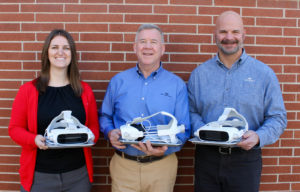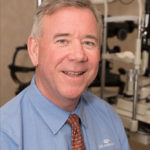
L-R: Drue Bahajak, OD, Gary Kirman, OD, and Stephen Baer, OD. The doctors hold the AdaptDx Pro device, which has changed the way they diagnose and serve AMD patients.
Sponsored Content
By ROB Editors
Dec. 16, 2020
Meet Gary Kirman, OD, second-generation owner of Kirman Eye, a private practice that’s served his community of Hummelstown, Penn., for more than 60 years. Due to the impact of age-related macular degeneration (AMD) on several of his family members, Dr. Kirman has been a staunch advocate of dark adaptation testing in optometric practice since the introduction of the technology in 2014. In fact, between Dr. Kirman, his two associate optometrists and two diagnostic technicians, the practice had been utilizing the original tabletop AdaptDx® daily since 2014.
Unfortunately, with only one dark room that contained multiple pieces of testing equipment, they continually had a three-month wait list for dark adaptation testing. Therefore, when the AdaptDx Pro™ was introduced, Dr. Kirman took “all-in” to a whole new level—buying not one, but three, AdaptDx Pro devices. What may look like a pretty big gamble to someone on the outside, seems to be paying off—for patients and for the practice’s bottom line. We caught up with Dr. Kirman recently and asked him about his bold decision. Here’s what he had to say.
ROB: Why did you choose to specialize in AMD?
Dr. Kirman: “After seeing the devastating effects of AMD on several of my family and friends, finding and treating this disease has been my passion and my purpose. AMD is not the only focus in our comprehensive practice; it’s just an essential component of optometric practice broadly speaking. AMD is important in the same way that detecting glaucoma is important in eyecare.
For example, by checking intraocular pressure and examining the back of the eye, we are effectively screening patients for glaucoma at every single exam. My diagnosticians also perform OCT, Optos, Visual Fields and Pachymetry. This is a testament to our commitment to performing all the tests necessary to detect glaucoma. When you consider the simple fact that AMD is three times more prevalent than glaucoma, you have to ask yourself whether or not you are also performing all the tests necessary to detect AMD. In my opinion, if we aren’t testing dark adaptation, we’re not doing all we can be doing and all we should be doing to diagnose AMD.”

Gary Kirman, OD, owner of Kirman Eye, a private practice in Hummelstown, Penn.
ROB: Why do you believe so strongly in dark adaptation testing in particular?
Dr. Kirman: “It is common knowledge that AMD is present before drusen are clinically visible. Furthermore, research unequivocally shows that subjects with impaired dark adaptation were twice as likely to develop clinically evident AMD and eight times as likely to advance beyond the earliest stage of AMD. But what really hits home is the fact that eyecare practitioners (ODs and MDs alike) are missing AMD about 25 percent of the time according to a study published in JAMA Ophthalmology.
As a consequence, up to 78 percent of AMD patients have substantial, irreversible vision loss at first treatment, including 37 percent who are legally blind in at least one eye. I don’t want to be part of this problem and I don’t want my patients to have to live with the life-altering consequences. Once I learned there was a simple functional test that could alert me to the presence of AMD and give my patients a fighting chance, there was no turning back!”
ROB: How reliable is the AdaptDx?
Dr. Kirman: “Several peer-reviewed studies have shown that dark adaptation function is impaired from the earliest stages of AMD, with increasing impairment as the disease progresses. The AdaptDx dark adaptometer in particular works by measuring a patient’s Rod Intercept™ (RI™) time. RI is the number of minutes it takes for the eye to adapt to darkness. The RI test results are easy to interpret with 90 percent sensitivity and specificity to the presence of AMD. Knowing this, what excuse could I possibly have for not using the AdaptDx with each and every patient over the age of 55 or a night vision complaint?
Just like a tonometer, visual field, OCT, ultra-widefield imaging, macular pigment optical density, meibography, or fluorescein dye, dark adaptometers are essential tools. They’re also exceedingly practical. The AdaptDx technology is a straightforward adjunct to OCT, fundus photography and standard clinical examination. At the end of the day, this functional test allows us to detect AMD up to three years before it becomes clinically evident.”
Learn More
ROB: Is the AdaptDx Pro a significant upgrade compared to the tabletop device?
Dr. Kirman: “The AdaptDx Pro is a wearable headset that requires no darkroom and features an artificial intelligence-driven onboard technician named Theia. The self-contained device was custom-designed and tested for patient comfort and includes all of the functionality and accuracy of the table-top dark adaptometer that we already had and loved. But the portable headset creates a comfortable, personal dark room so patients can take the test in any quiet, private space in the office, in any light—making it easier than ever to fit it into a routine workflow and giving us the ability to test many more patients.
Other Articles to Explore
After the office technician selects the testing protocol and places the device on the patient, Theia takes over using automated instructions and adaptive feedback spoken directly to the patient. Right off the bat, our technicians were happy to not have to sit in a darkroom to administer the test. Instead they are available to move around and manage OCTs and visual fields. The Pro has just freed up so much time while simultaneously allowing us to perform more same-day testing than ever before. And, with three AdaptDx Pro devices, they can test three patients at once because the screen displays a status bar, letting our technicians know which patient will be finishing soon.”
ROB: With three doctors, why would you need four dark adaptometers?
Dr. Kirman: “Before ordering our three new AdaptDx Pro headsets, I did an analysis of all the patients ages 55 and older who qualified for AdaptDx testing. With only one diagnostic dark room, which also contained our OCT, visual field, and MPOD instruments, “same day” testing was not achievable. We’d ask the patient to schedule the test and come back, but some patients never got around to it. With the addition of the three AdaptDx Pro units, we are still very busy, but we are detecting so much more AMD.
As a three-doctor practice, we wanted to have three headsets so there would always be one available for every patient that needed one. No patient has to wait. In short, it’s really about being able to ensure that our standard of care is met and, with only one unit, patients were falling through the cracks. We also keep the tabletop version available for the handful of patients who prefer it. In fact, there have been times when we have had all four of our dark adaptometers running at the same time.
Honestly, I couldn’t be prouder of how my associate doctors and diagnostic technicians have joined me in the fight against AMD.”
ROB: What should optometrists expect if they start using the AdaptDx Pro?
Dr. Kirman: “Obviously, age is the biggest risk factor for age-related macular degeneration. Therefore, when you have the tools you need to properly test all patients 55 and older, you’re going to find a lot more AMD. And when you find more AMD, you follow more AMD with other tests, like OCT, fundus photos, MPOD, and more frequent exam schedules. You will also prescribe AREDS2 vitamins, UV and blue light blocking lenses, and sunglasses. It’s a domino effect that’s good for the practice and great for the patient, who gets to take charge of their disease and, hopefully, also avoid sudden or premature vision loss.”

























